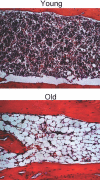Adipose-immune interactions during obesity and caloric restriction: reciprocal mechanisms regulating immunity and health span
- PMID: 18579754
- PMCID: PMC2638733
- DOI: 10.1189/jlb.0108028
Adipose-immune interactions during obesity and caloric restriction: reciprocal mechanisms regulating immunity and health span
Abstract
Increasing evidence suggests a tight coupling of metabolic and immune systems. This cross-talk mediated by neuroendocrine peptides as well as numerous cytokines and chemokines is believed to be responsible for integrating energy balance to immune function. These neuroendocrine-immune interactions are heightened during the state of chronic positive energy balance, as seen during obesity, and negative energy balance caused by caloric restriction (CR). Emerging evidence suggests that obesity may be associated with an immunodeficient state and chronic inflammation, which contribute to an increased risk of premature death. The direct interactions between expanded leukocyte populations within the adipose tissue during obesity and an increased number of adipocytes within an aging lymphoid microenvironment may constitute an important adaptive or pathological response as a result of change in energy balance. In stark contrast to obesity, CR causes negative energy balance and robustly prolongs a healthy lifespan in all of the species studied to date. Therefore, the endogenous neuroendocrine-metabolic sensors elevated or suppressed as a result of changes in energy balance may offer an important mechanism in understanding the antiaging and potential immune-enhancing nature of CR. Ghrelin, one such sensor of negative energy balance, is reduced during obesity and increased by CR. Ghrelin also regulates immune function by reducing proinflammatory cytokines and promotes thymopoiesis during aging and thus, may be a new CR mimetic target. The identification of immune effects and molecular pathways used by such orexigenic metabolic factors could offer potentially novel approaches to enhance immunity and increase healthy lifespan.
Figures





References
-
- Speakman J R. Obesity: the integrated roles of environment and genetics. J Nutr. 2004;134:2090S–2105S. - PubMed
-
- Fontaine K R, Barofsky I. Obesity and health-related quality of life. Obes Rev. 2001;2:173–182. - PubMed
-
- Caballero B. The global epidemic of obesity: an overview. Epidemiol Rev. 2007;29:1–5. - PubMed
-
- Flegal K M, Graubard B I, Williamson D F, Gail M H. Cause-specific excess deaths associated with underweight, overweight, and obesity. JAMA. 2007;298:2028–2037. - PubMed
Publication types
MeSH terms
Substances
Grants and funding
LinkOut - more resources
Full Text Sources
Medical

